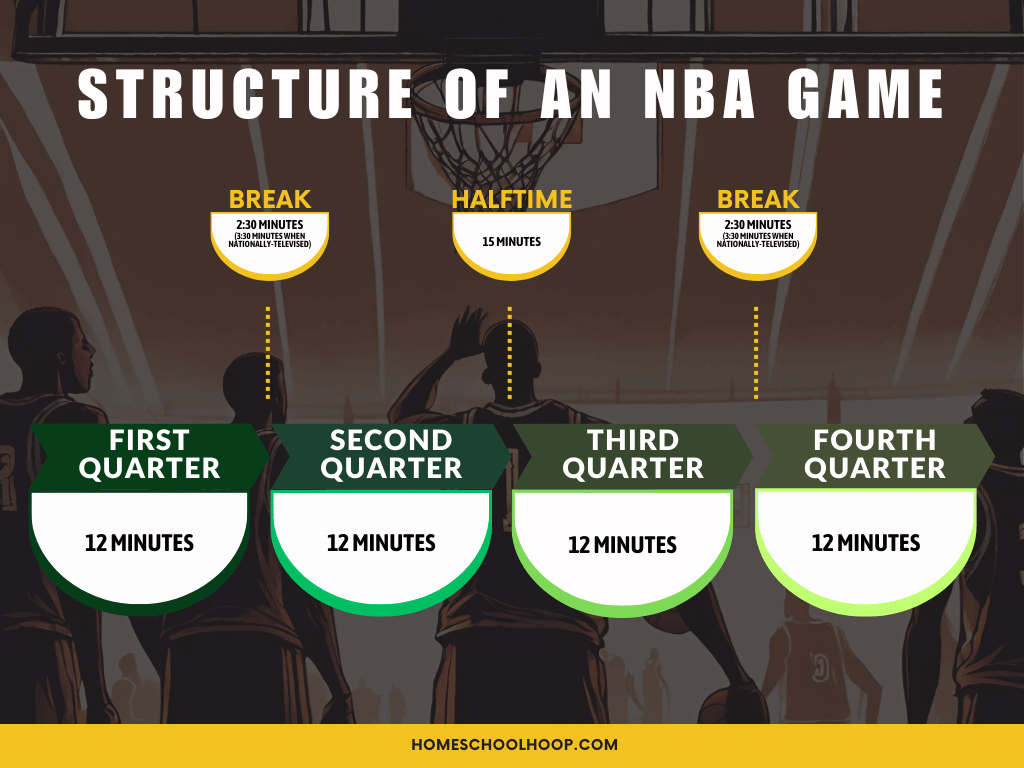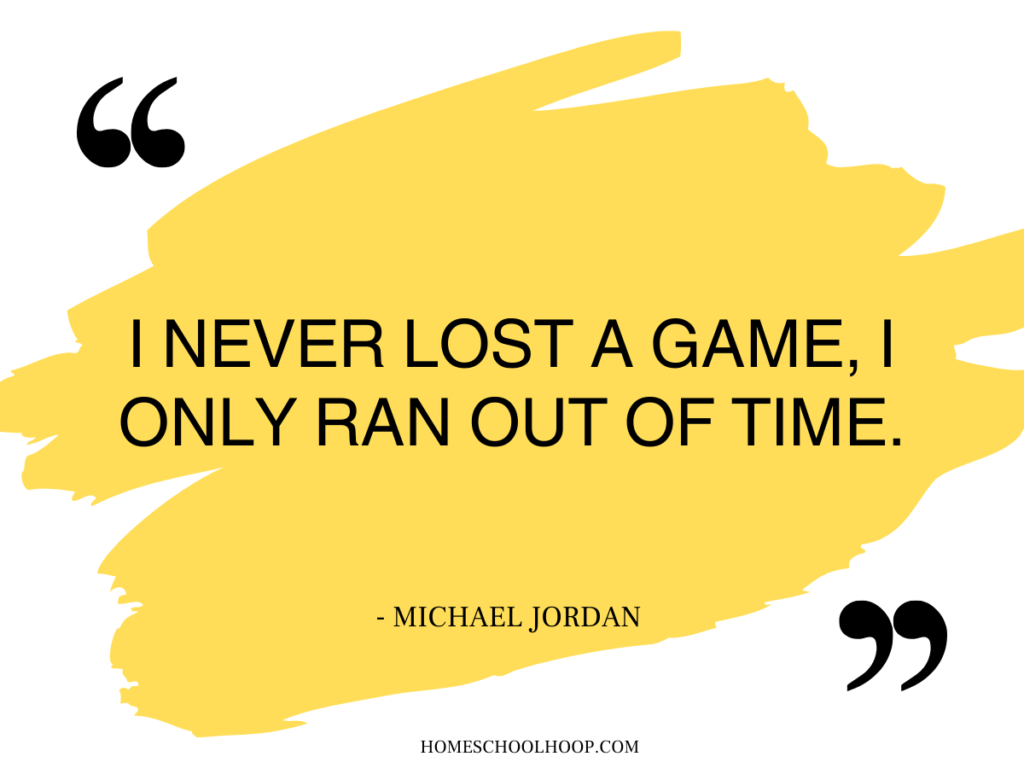When you watch an NBA game, you’re in for a lot of fast and exciting basketball. But you might wonder, how long does an NBA game last? Let’s look at the key points:
Key Takeaways:
- NBA Playing Time: An NBA game consists of four 12-minute quarters, totaling 48 minutes of playing time.
- Real-Time Duration: Usually, an NBA game lasts about 2 to 2.5 hours from start to finish.
- Influencing Factors: Various stoppages like timeouts, fouls, and commercials can extend the actual length of an NBA game.
Have you ever planned your evening around an NBA game, wondering how much time you’d need to set aside? Understanding the duration of NBA games, both in terms of playing time and real-time, sets you up for an enjoyable evening of basketball.
But it’s not just the 48 minutes of play that count. Other things like checking plays on video, players getting in and out of the game, and the halftime break adds to the total time. So, let’s dive deeper into what makes an NBA game a unique and time-bound spectacle.
Understanding the Structure of an NBA Game
An NBA game balances intense playing time with crucial rest and strategy periods. This structure, from quarters to halftime to possible overtimes, determines the time players are on the court and the overall duration of the game.

NBA Quarter Length
An NBA game is split into four parts, called quarters, and each one is 12 minutes long. So, the total playing time in an NBA game is 48 minutes unless the game goes into overtime. These quarters are where the basketball action happens.
NBA Quarter Breaks
During NBA games, there are short 2:30 breaks. These happen between the first and second quarters, again between the third and fourth quarters, and before any overtime periods. When games are nationally televised, these quarter breaks are 3:30. These stoppages let players rest for a moment and give coaches time to share quick tips.
NBA Halftime
Halfway through the game, after the second quarter, there’s a more extended break called halftime. It lasts 15 minutes. This break is essential for players to rest longer and for coaches to make more detailed plans. For fans, it’s a chance to grab a snack, use the restroom, or enjoy some entertainment.
NBA Overtime
If the game’s score is tied at the end of the fourth quarter, it goes into overtime. Each overtime period adds 5 minutes to the game. If the game is still tied after overtime, they keep playing additional overtimes until one team wins.
Learn more: How many NBA teams are there?
Factors Affecting the Length of NBA Games
While an NBA game has 48 minutes of playtime, several things can make the actual game last longer. These include planned breaks, advertisements, fouls, and unexpected events like injuries. Let’s look at these factors:
Timeouts and Commercials
Essential for strategy, these brief breaks can add up. In critical moments, coaches use these wisely to re-strategize.
- Teams use timeouts to plan strategies. Each team has seven timeouts per game, each lasting 75 seconds.
- Media timeouts are special breaks for TV commercials. These happen at set times and are longer, lasting 2:45 for local broadcasts and 3:15 for national ones.
- Adding up all these timeouts and commercial breaks means more time is added to the game.
Fouls and Free Throws
Fouls are a common part of the game, interrupting and affecting the game’s flow.
- When a foul happens, play stops, and in the case that the foul puts the opposing team in bonus, players take free throws, which adds time.
- Examples of fouls that stop the game are blocking fouls, reach-in fouls, and charges in basketball. Referees sometimes review these to make sure they get the call right.
- If a player gets six fouls, they have to leave the game. The team gets 30 seconds to put a new player in.
Injuries
Injuries in the NBA, from ankle sprains to more severe knee issues, are common.
- The game and clock stop when players are hurt until they’re cared for.
- The time for this can vary, making the game longer.
Quarter Breaks and Halftime
Every NBA game has stoppages between quarters that add minutes to the overall game time.
- There are short breaks between quarters. They last 2:30 or 3:30 for nationally-televised games.
- Halftime comes after the second quarter and is 15 minutes long.
- These breaks, especially halftime, are longer than others and contribute to the total time of the game.
Close Games and Playoff Games
There is a correlation between how long an NBA game is and whether it’s a postseason or regular season game. Also, whether a game is tight down the wire or one team is cruising influences NBA game length.
- Games decided by fewer points are, on average, longer than games that are blowouts.
- Coaches are more likely to use all timeouts in close games and make more substitutions, adding to the game time.
- Teams often use intentional fouling to stop the clock and draw out games when they’re close. Also, more 5 second rule violations occur toward the end of close games as the team down denies any inbound passes.
- Because of added commercials, playoff games are longer than regular season games.
These factors, from timeouts to injuries, all add to the length of an NBA game, making it last longer than the actual playing time.

The Evolution of Game Length in NBA History
The length of NBA games hasn’t always been what it is today. Over the years, rules, technology, and broadcasting changes have made games longer.
In the early years of the NBA, games were shorter. There were fewer commercials and less time spent on reviews. The game’s pace was different, too, often resulting in quicker matches.
As the NBA grew, it introduced new rules. Some of these changes affected game length. For example, introducing the 24-second shot clock in 1954 sped up the game. Teams had less time to hold onto the ball, making the game faster.
Other rule changes, like those for fouls and timeouts, also influenced the duration of games. Ahead of the 2021-2022 NBAseason, the league limited teams to two timeouts in the final three minutes of a game and eliminated the automatic reviews on all out-of-bounds plays in the final two minutes.
Technology has also made a big difference. With slow-motion replays and video reviews, games now have more breaks. Plus, the league’s growth now brings in more than $1 million in televised advertising dollars, leading to longer, more frequent commercial breaks that add to game length.
The NBA has looked at ways to keep games engaging in recent years. This includes managing the length of games. Changes like limiting timeouts in the final minutes, reducing the shot clock to 14 rather than a full 24 seconds following an offensive rebound, and penalizing transition take fouls help keep the game moving.
Learn more: The Ultimate NBA Fan Guide
NBA Games vs. Other Sports: A Time Comparison
NBA games have a unique duration compared to other major sports like NFL football, MLB baseball, and soccer. Let’s see how they compare:
Compared to NFL Games:
- NFL games usually last about 3 hours in real-time, making them longer than NBA games.
- They play four 15-minute quarters, and the clock stops frequently for various reasons.
Compared to MLB Games:
- MLB games have no set time limit and can vary a lot. On average, they last about 2 hours and 45 minutes, thanks to recent rule changes.
- Baseball is different because it’s based on innings, not a running clock like basketball. Even with the pitch clock, this often results in longer games than the NBA.
Compared to Soccer:
- A soccer match typically lasts 90 minutes, not including extra time.
- Soccer has two 45-minute halves with a running clock, making these games generally shorter than NBA games.
The reason that NBA games are shorter or longer than other sports is how the game is timed. Basketball’s continuous clock but frequent stoppages and specific rules around timeouts and quarters create a different pace and total game time than other sports.
The Fan Experience: How Game Duration Impacts Viewers
Has the NBA game length ever influenced whether you turn the game on or not? You’re not alone. The length of NBA games affects how you enjoy basketball, whether watching in person at the arena or on TV.
Those in the arena get a complete experience, from pre-game activities to post-game shows. The 2 to 2.5 hours of an NBA game can feel more engaging in person. You may feel the game is longer at home because of TV commercials and timeouts. This can impact how closely you follow the game.
NBA executives hope to dial in the duration of NBA games, so they’re just right for keeping fans engaged: Long enough to build excitement with twists and turns but not too long to lose interest. Shorer games like soccer may not offer enough time for storylines to develop. Longer games, like baseball, can sometimes lose the audience’s attention.
FAQs
How long is a typical NBA game?
NBA games consist of 48 minutes of playtime (4 quarters of 12 minutes each) but generally last 2 to 3 hours because of various stoppages.
How long is a quarter in the NBA?
Each NBA game is divided into four quarters, each lasting 12 minutes.
How long is between quarters in the NBA?
NBA breaks between the first and second and third and fourth quarters are two minutes and 30 seconds. However, these breaks are three minutes and 30 seconds when NBA games are nationally televised.
What is the longest NBA game ever played?
The longest recorded NBA game lasted 78 minutes and went into six overtimes. It was a 1951 matchup between the Indianapolis Olympians and the Rochester Royals.
How does the NBA’s game length compare to college basketball?
Men’s college basketball games are typically shorter than NBA game time, with two 20-minute halves. Our guide – How long is a basketball game? – breaks down game duration differences between levels.
Does the NBA have plans to change game lengths?
The NBA constantly evaluates its game structure, but there’s no indication that any major changes to game length are on the horizon.

